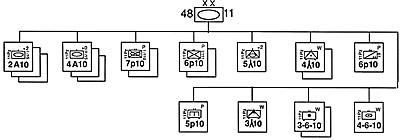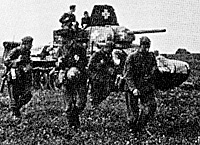 During the battles depicted in this game, the 48th Panzer Korps
consisted of Group Adam, the 336th Infantry Division, group
Stumpfeld, the 7th Luftwaffe Field Division, and when it arrived, the
11th Panzer Division. These units were rapidly thrown together to
reconstitute the Panzer Korps, which had been destroyed while
resisting the Russians' Operation Uranus. Indeed, the only units in the
game which were present in the 48th Korps during the November
battles were those of Group Schmid of the 14th Panzer Division.
During the battles depicted in this game, the 48th Panzer Korps
consisted of Group Adam, the 336th Infantry Division, group
Stumpfeld, the 7th Luftwaffe Field Division, and when it arrived, the
11th Panzer Division. These units were rapidly thrown together to
reconstitute the Panzer Korps, which had been destroyed while
resisting the Russians' Operation Uranus. Indeed, the only units in the
game which were present in the 48th Korps during the November
battles were those of Group Schmid of the 14th Panzer Division.
As the Russians moved to surround the 6th Army, they used the Chir River to cover the outer flank of their encirclement. While they did attack southwards on this line, their efforts in this direction were insignificant when compared to the massive efforts in the direction of Stalingrad. Thus the Germans were given a chance to form a line in this sector.
But with what? There were no major formations available to hold the line, the job of forming the line fell to a few enterprising officers. These men collected stragglers from shattered units, cadets from the Officer School of the 6th Army, the Pioneer School at Kalach, men returning from leave, and various engineer and security units and formed them into rifle units. These improvised units grew in size and strength until both Group Adam and Group Stumpfeld were of divisional strength. In fact, near the end of the battles covered in this game, Group Adam was dissolved and renamed the 384th Infantry Division. It was then commanded by General von der Galbencia and his staff, who had been flown out of the Stalingrad pocket.
There was a high price to pay for forming these ad hoc formations. The furlough battalions took desperately needed men from regular fighting formations and used them as riflemen in these stopgap units, which had minimal fighting value. The same goes for the various engineer units and cadets.
Many of these specialized, difficult-to-replace men were lost. The very nature of these units caused them to be less effective than regular formations. They had no signals equipment, nor any heavy weapons. It took more men to generate the same firepower than a regular, well trained unit could.
Some of the leaders of these groups deserve special mention. Col. Adam was the officer in charge of personnel records of the 6th Army. He had the good luck to be caught outside the pocket and found himself in the Don-Chir triangle. Col. Sauerbruch fought under Col. Adam. He led his own Regiment of Police and Security troops, which fought well. This was especially impressive as these men faced the 4th Mechanized Corps. one of the best units on the Russian side.
Col. Stumpfeld commanded mostly engineering troops. These units were generally not as effective as Group Adam, though this was due more to the effect of terrain than troop quality. One unit of interest in Group Stumpfeld was the tank unit of Koruck 593. This force consisted of about 10 captured Russian tanks, which were used to train the engineers at Kalach in anti-tank techniques. When the Germans were sent packing from Kalach, the tanks went along and came in handy along the Chir.
Much has been written about the failure of the Luftwaffe Field Divisions and the 7th was no exception. One battalion simply drove into the Russian line and was wiped out. After the initial failure, the division was separated into small components and used to bolster the 336th Infantry Division. The 7th Luftwaffe Field Division was reconstituted after these battles and used for rear area security work. The unfortunate part of all this is that the men of these divisions were of high quality and were lavishly equipped. It was their lack of training and effective leadership which caused them to fail.
 Of all the units in this game, the 336th Infantry Division is by
far the best documented. It arrived in the 48th Panzer Korps area on
December Sth, from the Hungarian Army sector. Unfortunately, only
two-thirds of the division arrived. The anti-tank battalion went to
Group Stahel, just off the west edge of the game map, while an artillery
battalion, the Feld-Aufsbildung Battalion, the Reserve Battalion, and an
entire infantry regiment stayed in the Hungarian Army area. Each
infantry regiment had to disband a battalion to bring the other two up to strength.
Of all the units in this game, the 336th Infantry Division is by
far the best documented. It arrived in the 48th Panzer Korps area on
December Sth, from the Hungarian Army sector. Unfortunately, only
two-thirds of the division arrived. The anti-tank battalion went to
Group Stahel, just off the west edge of the game map, while an artillery
battalion, the Feld-Aufsbildung Battalion, the Reserve Battalion, and an
entire infantry regiment stayed in the Hungarian Army area. Each
infantry regiment had to disband a battalion to bring the other two up to strength.
Finally, the 11th Panzer Division was one of the more difficult units to research. Authors seemed to avoid mentioning it on purpose. Alan Clark, in Barbarossa, mentions a strength of over 100 armored vehicles. This is much too high. Even counting halftracks and recon vehicles, the total available would be no more than 80.
A more accurate assessment can be found in Warlimont's Inside Hitler's Headquarters. This book details a discussion between Hitler and his Chief of Staff, Zietzler, over the strength of 11th Panzer. Hitler claimed a strength of 79 tanks, while Zietzler mentioned 45. When Hitler pressed him about the discrepancy, Zietzler attempted to attribute it to breakdowns. While he was correct about the number of tanks available, he was wrong about the reason.
The missing tanks can be found in another game, GDW's White Death. When the 11th Panzer Division was transferred out of Army Group Center, half of the 1st Battalion, 15th Panzer Regiment stayed behind and was sent to fight at Velikiye Luki. This practice of dividing up formations became a common practice in the German Army, an unfortunate consequence of their strategic bankruptcy.
The 15th Panzer Regiment was equipped almost entirely with Pzkw III's, with one company of Pzkw II's and one of Pzkw IV's. About 15 to 20 percent of the Pzkw III and IV types were short barreled. It's easy to see that this division was not overwhelmingly powerful. It owed its success to excellent leadership.
On the Russian side, one finds units weakened, not so much by combat, but by a 200 mile chase from their bridgeheads on the Don River. Of all the Russian units, the 26th Tank Corps had the toughest going. It fought and destroyed the 22nd Panzer Division, raced to the Don and forced a crossing at Kalach, then battled the 3rd Motorized Division to a standstill at Marinovka. Only then did it turn south towards Novomaksimovskiy.
Shortly after the end of this game, 26th Tank Corps was withdrawn into STAVKA reserve and re-emerged as the 1st Guards Tank Corps.
The 4th Mechanized Corps was another excellent unit. this Corps was largely responsible for the southern encirclement of the 6th Army. The 13th Mechanized Corps had been halted by a counterattack by the German 29th Motorized division. This left only the 4th Mechanized to advance, which it did in fine style, linking up with the 26th Tank Corps. After attacking unsuccessfully against the German bridgehead across the Don, the 4th was pulled out, only to be thrown against the 57th Panzer Korps, attempting to relieve the 6th Army at Stalingrad. In this encounter, the 4th Mechanized Corps was nearly destroyed, and was withdrawn. It returned later in the war as the 3rd Guards Mechanized Corps.
The 5th Mechanized Corps was something of a mixed bag. The two tank regiments, the 59th and 60th, performed very poorly, losing 65 tanks without inflicting any losses on the Germans. These two tank regiments were equipped with American tanks, probably Stuarts, Grants, and Lees. Shermans hadn't started arriving at the front yet. The infantry fought well, however, and caused the 11th Panzer some anxious moments north of Oblivskaya.
The 1st Tank Corps suffered under a self-imposed handicap. Almost half of the Corps was detached and committed to the attack just west of the map area. These units included the 159th Tank Brigade, half of the 89th Tank Brigade and all of the 44th Motorized Infantry Brigade. To compensate for these detachments, the Corps received the 15th Guards Tank Brigade and the 216th Tank Brigade. The latter came from the 26th Tank Corps.
The 1st and 26th Tank Corps were equipped in the same way. Each tank brigade had a battalion of T-34/76's and one of T-70's. Of the former, much has been written. The T-70 is less known. It had decent armor and a gun comparable to the German 50mm. Both vehicles were superior to their German counterparts.
It was the 1st Tank Corps that supposedly fought the Battle of Sowchos 79. The actual battle took place no where near Sowchos 79. It took place about 10 miles to the east, near Nizhne Solonovskiy and Sysoykin. The 1st Tank Corps had curled in behind the 336th Infantry Division and had halted to prepare to attack in the morning. The timely arrival of the 11th Panzer Division upset this plan. The Germans attacked on both sides of Nizhne Solonovskiy and drove the Russians back across the Chir.
Contrary to some accounts, the 1st was not destroyed. This is evidenced by the fact that this tank corps attacked twice, later in the battle, in the Nizhne Kalinovskiy area. It proved to be quite a thorn in the Germans' side.
One final note on these battles. Some sources cite Herman Balck, the commander of the 11th Panzer Division, as the victor of the "Sowchos 79" battles. While he does deserve credit for many successes before and after these battles, this is one he did not engineer. He was checking out the terrain in the German bridgehead area for a possible attack and did not arrive in the division's area until the morning of the 9th, after the battle was over.
Back to Table of Contents: CounterAttack # 3
To CounterAttack List of Issues
To MagWeb Master Magazine List
© Copyright 1991 by Pacific Rim Publishing Company.
This article appears in MagWeb.com (Magazine Web) on the Internet World Wide Web.
Other articles from military history and related magazines are available at http://www.magweb.com